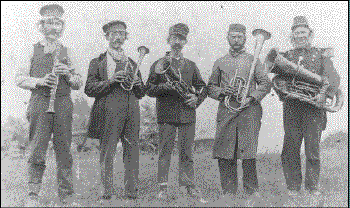
Sidney's Dutch Band. From left: Charles Martz,
Joe Wurstner, August (Pink) Schearer,
Adam Heineman, and Frazier Horr.
Bunnelle: After George H. Bunnelle came to Sidney he joined
Haleman’s band and it eventually became the Bunnelle band. Mr. Bunnelle was a
somewhat noted cornet player and organized his band during the summer of 1875, less than a
year after the Tappe band was organized. Bunnelle’s band, however, only existed for a
year; his popularity being so eclipsed by Tappe.
One reason was that Bunnelle tried to play music that was too high
class for the musicians he had while Mr. Tappe played music of a more popular nature. Both
bands gave a concert each week from a stand that stood in the square on the north side of
the courthouse. They were bitter rivals.
Many times when the band was giving a concert, the lights would be
turned out by enthusiasts of the other organization and it was no uncommon thing for one
band to be given a shower of gravel while playing. The Tappe band was called the
"Cornfield Sailors" by the Bunnelle followers and the Bunnelle boys were called
the "Mossbacks" by the Tappe enthusiasts. The Bunnelle band had among its
players: George H. Bunnelle, Captain Wm. H. Taylor, George Eddy, George Kah Sr., and a few
others who had played in the Haleman band.
Germania: Another
band was the Germania which was organized in 1875. It was composed of: John H. Wagner,
clarinet; W. O. Amann, B flat cornet; W. O. Wagner, first alto; Clemens Amann, second
alto; W. H. Wagner, baritone; Fred Montanus, tuba. This band was organized for the
amusement of the members. It had an existence of three or four years or until several of
its members went into business for themselves and did not have the time to devote to it.
It gave weekly concerts in the old balcony on the front of the Monumental building on
Wednesday evenings. On a Fourth of July morning shortly after its organization and when
only two pieces had been learned, the members went to the top of the Monumental building
which had just been completed and gave a concert at two o’clock in the morning,
alternating the two pieces which were "The Star Spangled Banner" and "My
Country ‘Tis of Thee."
Rebstock: Another
contemporary with the Tappe band was the Rebstock band, led by W.J. Rebstock, organized in
1877 and lasted three or four years. Their rehearsals were held in the Burkhardt building.
One Fourth of July this band came out to play and after getting out on the street found
that the Tappe band was out playing. Thinking they could not compete with the Tappe band,
they went over into east Sidney and spent the day playing there, to the gratification of
east Sidney residents. Tappe: Born in 1842 at Cincinnati,
Ohio, of a family of musical instrument makers, Herman Tappe resided in Piqua before
coming to Sidney. He was a cigar maker by trade, his factory being located where the
family residence "The Chimneys"
now stands. His cigar store was located on the corner now occupied by the Citizens bank
building (1938). His brother Carl was associated with him in the business. Rehearsals were
held on the third floor of the building known as the Hickok corner. Later, headquarters
were moved to the Eisenstein building, known then as the Singer Hall building. They
participated in practically every social gathering of that day and hardly an issue of the Shelby
County Democrat failed to contain accounts of appearances of Tappe’s band.
They played for the corner stone laying of the Monumental building in
1875, sporting a drum major for the first time which was the highest achievement a band of
that period could attain. They also played for the corner stone laying of the court house on July the Fourth,
1881.
The corner stone contains a list of the members of Tappe’s band.
Just to show the importance of bands in those days the line of march of the parade for the
corner stone laying was Anna band, Knights of Pythias, Martial band, Grand Army of the
Republic, Piqua band, county and city officials in carriages, citizens on foot, Union City
band, fire department, Odd Fellows, Tappe band, Masons.
Tappe
received an offer to play the Memorial day, 1881, services at Springfield, Ohio. After
conferring with the local officials it was learned that they could not offer nearly the
amount Springfield offered even in view of the expense of transportation incurred, so
Tappe’s band played at Springfield on that Decoration day, much to the indignation of
the local citizens. In January 1880, Tappe’s band was awarded the silver horn at the
Catholic festival here. At a band tournament at Troy, Ohio, they won the prize of one
hundred dollars in gold.
On the day of this tournament, their rivals, the Rebstock band were
giving a picnic in a grove at the north edge of town, known as the English woods. When the
news of Tappe’s success was received in Sidney, which was immediately after the
decision, the Rebstock boys planned a reception for them. When the train, bringing the
tired but jubilant band pulled into the depot at two a.m. the Rebstock band met them and
escorted them to the square, where, in the wee hours of the morning, they had to play one
of the prize winning numbers, "Crown of Diamonds," and listen to a lot of
eulogistic speeches, compliments and congratulations, while a prominent citizen held aloft
the five golden double eagles.
The supremacy of Tappe’s band can be attributed as in most cases,
to the skill of its director. That Mr. Tappe’s musicianship was not only of the showy
type is attested to by the fact that many of the numbers on his programs were of his own
composition and arrangement. His band flourished and prospered until about a year before
his death on Saturday, June 2, 1883, when failing health forced him into retirement.
The Shelby County Democrat of
that date contained the following in regard to Mr. Tappe: "He was a natural musician
and the organizer of several bands, one of which, under his leadership, was known
throughout the state. He was buried on Monday from the church of the Holy Angels. Members
of his old band, assisted by others, performed duty as escort, sounding the mournful
notes, which the silent tongue had taught them. His foibles, whatever they may have been,
are covered under the broad mantle of a music-loving peoples’ charity."
Klute: About
the time the Klute band was organized Sidney had a full grown epidemic of
"band," there being no less than five in active rehearsal at one time; but most
of them being composed of boys, they soon went out of "commission." The
organization of the Klute band was the strongest element in education of the musical taste
that ever flourished in Sidney. Its career, extending through exactly twenty years, was a
continued success. Its reputation and efficiency had a year by year growth. Mainly because
from the beginning, Mr. Klute aimed high always adhering to the rule he laid down, to play
good music.
Henry Klute came to Sidney for the first time in July 1878, when he was
asked to bring a band from New Bremen to play at the fourth congressional district
Democratic mass convention at which General Benjamin F. LeFevre, of Maplewood, was
nominated for congress the first time. Mr. Klute brought a band of six pieces to the
convention, the trip being made by canal boat, one of the modes of transportation at that time. The band boarded the boat at New
Bremen, coming down the canal through Minster and Fort Loramie to Lockington, taking the
canal feeder up to Sidney from Lockington. That band so captivated the convention that
immediate steps were taken to bring Mr. Klute to Sidney.
He came here to reside permanently in 1880. He was a cigar maker and carpet weaver by
trade. When he was not working in the cigar factory of John Pfeil, he wove carpets at his
home which was located where the Dixie Oil station now stands (1938). Mr. Klute organized
his band in 1880 with but six members: Henry Klute, E flat clarinet; E. E. Kah, cornet;
Joe Burkhardt, tenor; George Faver, baritone; and W. P. Harmony, bass, their object being
mutual pleasure and improvement.
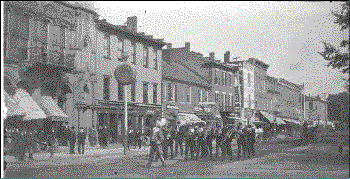
The Klute Band marching in downtown
Sidney
The first rehearsals were held in the room in
the Taylor building used by the Daughters of
Isabella. Taylor's hall, now the K. of C. hall, was used as a skating rink that winter and
after much deliberation on the part of the band, a contract to play for the skaters was
made, being the first engagement the Klute band had filled. This arrangement continued
throughout the winter to the satisfaction of all, but it proved to be the death blow to
the strictly private feature of the band for on the following Decoration day the band accepted an
engagement to lead the procession.
This engagement showed the necessity
for a stronger instrumentation and especially for drums, if it was to become a successful
marching band. Consequently, George Kleckner, snare drummer; Charles Kraft, bass drummer;
Adam Heineman, alto and C. E. White, alto, were added and Joe Wurstner changed to cornet.
The band now gave up all idea of being anything less than a marching band and continued to
add men as they offered until it numbered sixteen members.
The building on east Poplar street, afterward used as the armory, was
built originally as a skating rink during the winter of 1884-1885 and was operated by
Klute’s band for three or four years. In 1887 the members of Klute’s band joined
the Ohio National Guard as the official band of the Third Regiment and served for three
years. In 1893 Klute’s band headed the Ohio delegation in the parade of the G.A.R.
encampment at Pittsburgh. They were there the entire week. Klute’s band like the
Tappe band was widely acclaimed, filling numerous engagements in Sidney as well as in
various cities of the United States.
In 1894 occurred an event that for a time threatened the life of the
Klute band for on October the twenty-fifth of that year, Mr. Klute died very suddenly. The
blow was almost more than the organization could stand. However, the boys managed to stick
together until spring with Joe Wurstner as leader, when a number of good citizens came to
the rescue by forming a stock company, selling shares at twenty-five dollars each. Louis
Kah was secretary and Mr. Laughlin was president of the company. The writer has in his
possession one of these shares, dated June 24, 1895.
This is where B. O. Worrell entered the
picture. He was on the road with Sells Brothers circus and had been married two or three
months and wanted to settle down. The circus he was with happened to be playing Sidney and
he entered Burkhardt’s shoe store to inquire about the band situation here. Mr.
Burkhardt told him of Mr. Klute’s death some months before and also told him to see
Louis Kah. He wrote to Mr. Kah on the following day and three weeks later Worrell was on
the job as director of the Klute band.
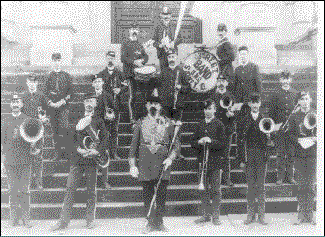
The Third Infantry Ohio National Guard
Band on the Courthouse steps
Prof. Worrell took hold of matters in so
masterful a way that it was not long until the band was getting along nicely and adding
new laurels to those previously gained. During Worrell’s time the band played many
important jobs at Union City, Piqua, Dayton, Cincinnati, Springfield, Columbus and Lima.
On one engagement at Marion, Ohio, in 1899 during a K of P. convention, there were many
bands engaged from all over the state. It was at this convention that Mr. Worrell met the
then future President Harding who was playing cornet with the Marion band. After Mr.
Worrell had been here ten years, he located a position in Ottumwa, Iowa, going there to
assume leadership of the Iowa state band. (Sidney Daily News, Oct. 25, 1938)
The Sidney Kiwanis Band: After the death
of Henry Klute, the Klute band was taken over by Mr. B. O. Worrell. He directed the band
for ten years and then left to assume the leadership of the Iowa State band.
Around 1921, he returned to Sidney. According to Mr. Schaefer, the city
fathers lamented the fact that Sidney was without a band and the Sidney Kiwanis Band was
formed with Prof. Worrell as the leader.
Mr. Schaefer and Sidney resident Thomas Faulkner were members of this
band when they represented Ohio at the Kiwanis International convention in Atlanta in May
1923. The Atlanta Constitution newspaper reported that "Ohio does not need to play
second fiddle in this line of music to any state in the union."
The big event of the convention week was
the opportunity to broadcast a concert over radio station WSB, the Atlanta Journal
station. Citizens of Sidney gathered in the high school auditorium to hear the concert
featuring a solo by Homer Crusey. George E. "Tubby" Essington, a former
drum major for the Ohio State University Marching Band, was the drum major for the Sidney
Kiwanis Band. The newspaper described him as "the most resplendent drum major on
earth whose regalia would dim a Mexican general’s uniform."
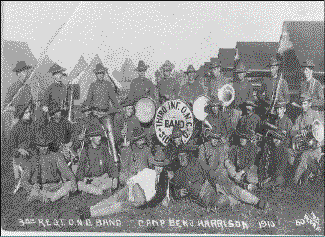
The Third Infantry Ohio National Guard
Band in 1910
In January 1924 the band gave an outstanding
musical program at the Majestic Theatre with every seat being taken except for a few seats
down front. There were a number of persons in the large audience from other places who
would endeavor to secure the band for a concert at their home cities before the summer
season. Later the title of Sidney Municipal Band was adopted in order to gain
financial support from the city council after sponsorship began to wane. In the summer of
1930 the band folded because of the lack of money during the great depression.
Historical society member Art Killian recalls when he took music lessons
from Mr. Worrell. Mr. Worrell had rooms on the second floor of the building at the
southwest corner of North and Main streets. He remembers Mr. Worrell as a dapper man
dressed in white suit, a taskmaster who was always addressed as Mr. Worrell or Professor.
(Sidney Daily News, May 26, 1988; Columbus Dispatch, n.d.;
personal interviews)
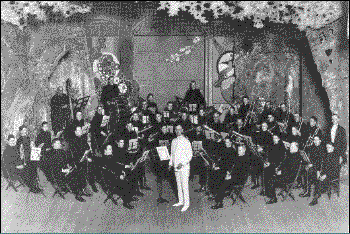
Sidney Kiwanis Band, 1921, B.O. Worrell, Director
[ Back to Entertainment Index ] |

